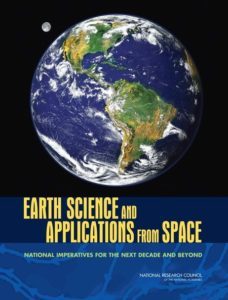2017-2027 Decadal Survey for Earth Science and Applications from Space
The National Academies of Sciences, Engineering, and Medicine, led by the Space Studies Board, has organized the 2017-2027 Decadal Survey for Earth Science and Applications from Space (ESAS 2017) to help shape science priorities and guide agency investments into the next decade.

The survey, sponsored by NASA, NOAA, and the USGS, is driven by input from the scientific community and policy experts. ESAS 2017 will generate recommendations from the environmental monitoring and Earth science and applications communities for an integrated and sustainable approach to the conduct of the U.S. government’s civilian space-based Earth-system science programs. The current Survey builds off ESAS 2007, the first-ever comprehensive survey of all Earth sciences from space-borne observations, also supported by NASA, NOAA, and USGS. Over the course of a year and a half, participants in the ESAS 2017 will generate consensus recommendations from the environmental monitoring and Earth science and applications community on an integrated and sustainable approach to the conduct of the U.S. government’s civilian space-based Earth-system science programs.
ESAS 2017 is composed of five topical area panels that are intended to cover the major components of Earth system science, be consistent the Decadal Survey Statement of Task, be informed by community input received in the first Request for Information (RFI), and be reflective the missions and goals of the sponsoring agencies:
I. Global Hydrological Cycles and Water Resources—The movement, distribution, and availability of water and how these are changing over time.
II. Weather and Air Quality: Minutes to Subseasonal—Atmospheric Dynamics, Thermodynamics, Chemistry, and their interactions at land and ocean interfaces
III. Marine and Terrestrial Ecosystems and Natural Resource Management—Biogeochemical Cycles, Ecosystem Functioning, Biodiversity, and factors that influence health and ecosystem services
IV. Climate Variability and Change: Seasonal to Centennial—Forcings and Feedbacks of the Ocean, Atmosphere, Land, and Cryosphere within the Coupled Climate System
V. Earth Surface and Interior: Dynamics and Hazards—Core, mantle, lithosphere, and surface processes, system interactions, and the hazards they generate
INNOVIM’s Chief Science Officer, Dr. Philip Ardanuy, is serving on the ESAS 2017 Weather and Air Quality Panel. He also served on the Societal Applications Panel on ESAS 2007, and on the Earth Science and Applications from Space Midterm Assessment of NASA’s Implementation of the Decadal Survey (2012).
